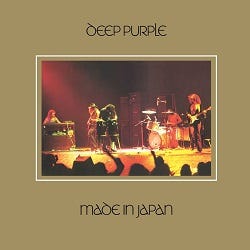The 25 Best Live Rock Recordings - No. 14: Made In Japan
No. 14 - Deep Purple - Made In Japan (Purple, 1972)
Sometimes it’s about timing and talent. Deep Purple achieved their classic quintet of lead vocalist Ian Gillan, guitarist Richie Blackmore, bassist Roger Glover, keyboardist Jon Lord, and drummer Ian Paice with the release of the experimental Concerto for Group and Orchestra (Tetragrammaton, 1969) and with that out of their system, followed with the critically accepted Deep Purple in Rock (Warner Bros, 1970) and Fireball (Harvest, 1971). Before recording their watershed Machine Head (Purple, 1972) the band had toured almost constantly with In Rock and Fireball being recorded between live appearances.
The band wanted to record what would become the watershed Machine Head differently. Feeling their recent studio experiences lacking, the band wanted something other than the soundproofed studio environs. They decided on the Montreux Casino in Switzerland, where they looked forward to an extended period of no touring. Ensconced in the casino, courtesy of Claude Nobs, and ready to record using the Rolling Stones Mobile Studio. The plan was for the band to arrive after the season's final concert so they would have the location to themselves. In return, the band would perform a show at the casino.
In December 1971, the season’s last performance was Frank Zappa and the Mothers of Invention. During that show, and while Deep Purple was some distance away at a restaurant, an audience member fired a flare into the venue’s roof, causing the famous fire in “Smoke On The Water,” the centerpiece of many on what would become Machine Head.
This put quite the kink into the band’s plans. Nobs relocated them to a local theater called the Pavillon, which turned out to be a less-than-optimal recording space. From the Pavillon, Deep Purple made their way where? The empty Grand Hotel on the outskirts of the city. After moving the Rolling Stones Mobile Studio to the front of the building, the band set up in a hallway off the main lobby and, in the staid tradition of elegantly stoned hardship recorded their masterpiece (not at all unlike how and why the Rolling Stones recorded their masterpiece, Exile On Main St. (Rolling Stones, 1972).
Machine Head was recorded between December 6-21, 1971, and released on March 25, 1972. They returned to touring almost immediately, appearing in Hamberg, Germany on January 5, 1972. This was the beginning of a world tour to support Machine Head, with the band making it through the United States, Europe, Canada, and England before making it to the Far East. The band appeared for three nights in Japan: August 15-16, 1972 at the Koseinenkin Kaikan in Osaka, and on August 17, 1972, at Koseinenkin Nippon Budokan in Tokyo. These concerts provided the source material for Made In Japan.
The setlists for these concerts are identical except for the encores (not released on the original 2-LP set, but later on Made in Japan, The Deluxe Edition (Rhino Entertainment, 2014)). Where the August 15th and 17th shows featured “Black Night” and “Speed King” and the August 16 show featured “Black Night” and “Lucille.” The programming order on the release is faithful to the original setlist order with the exception that “Smoke On The Water” and “Child In Time” switched places (surely for dramatic effect on the release, to build tension in the listening experience).
The music. The music was as if ordered and delivered right on time. While the Rolling Stones were codifying American Music on Exile On Main Street, Led Zeppelin was becoming LED ZEPPELIN with Led Zeppelin IV (Atlantic, 1971), and the Who was defining rock music for a generation on Who’s Next (Decca, 1971), Deep Purple was blowing the doors off with music meant for nothing else but to be one big flex of heavy metal muscle, when it still meant something.
The opening “Highway Star” from MH, emerges from the band’s pre-concert noodling with Ian Paice’s snare drum giving premonition to Richie Blackmore’s signature high-volume sliding over the strings, establishing him as a foremost guitarist. Where Jimmy Page was studio technique and stage authenticity, Blackmore was playing Franz Liszt against Niccolo Paganini in establishing the artist as god over the music. This recording belonged to Blackmore and organist Jon Lord who shared the stage equally with Ian Gillan. They established the menace for Gillan on “Child In Time” (from Deep Purple In Rock) and anchored the boogie of “Strange Kind Of Woman” (From Fireball).
Ian Pace and bassist Roger Glover flex their muscles on “The Mule” (From Fireball), which acts as a warm-up to the concert’s climax, the molten blues of “Lazy” where Jon Lord extracts the organ rock soul from Keith Emerson, pouring it into a roiling convulsion of intentionally confused musical history, quoting “Louie, Louie” and “C-Jam Blues” in the same exhalation before strolling and letting Blackmore do his thing. Then the familiar head followed by seething blues-rock. Blackmore hits the compressor, kicking open the doors, leaving “Smoke On The Water” almost an afterthought. “Space Truckin’” is all icing, 20 minutes of it, to conclude a definitive live rock statement.



